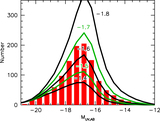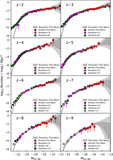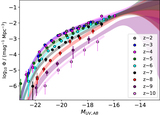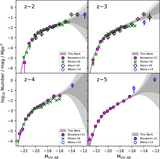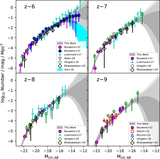Image Details

Caption: Figure 9.
Sixty-eight percent and 95% confidence intervals on the inferred UV luminosity density and unobscured SFR density (blue and cyan shaded regions) at z ∼ 2–9 derived from our new UV LF results integrated down to −13 mag (Section 4.2). Also shown are the obscured SFR density results (orange-shaded region) derived by Bouwens et al. (2020) from z ∼ 8 to z ∼ 2 by applying the ASPECS IRX results to z ∼ 4–8 samples, making use of published ULIRG results (shown with the hatched red region) by Wang et al. (2019; dark red points), Franco et al. (2020a, 2020b; red points), and Dudzevičiūtė et al. (2020; solid brownish-yellow circles), and adopting the z = 2-3 dust extinction estimates from Reddy et & Steidel (2009). The shaded orange region from z = 0 to z = 2 shows the constraints on the obscured SFR density from Magnelli et al. (2013), while the blue and cyan shaded regions at z < 2 show the constraints from Wyder et al. (2005) and Moutard et al. (2020). The blue lines show the UV luminosity densities and SFR densities we derive from our LF results brighter than −17 mag at z > 2 and Wyder et al. (2005) and Moutard et al. (2020) found at z < 2. As Bouwens et al. (2009a, 2016b), Dunlop et al. (2017), and Zavala et al. (2021) previously concluded, the bulk of the SFR density is unobscured at z > 4 and obscured at z < 4. There is a transition between the two regimes at z = 4.
Copyright and Terms & Conditions
© 2022. The Author(s). Published by the American Astronomical Society.



